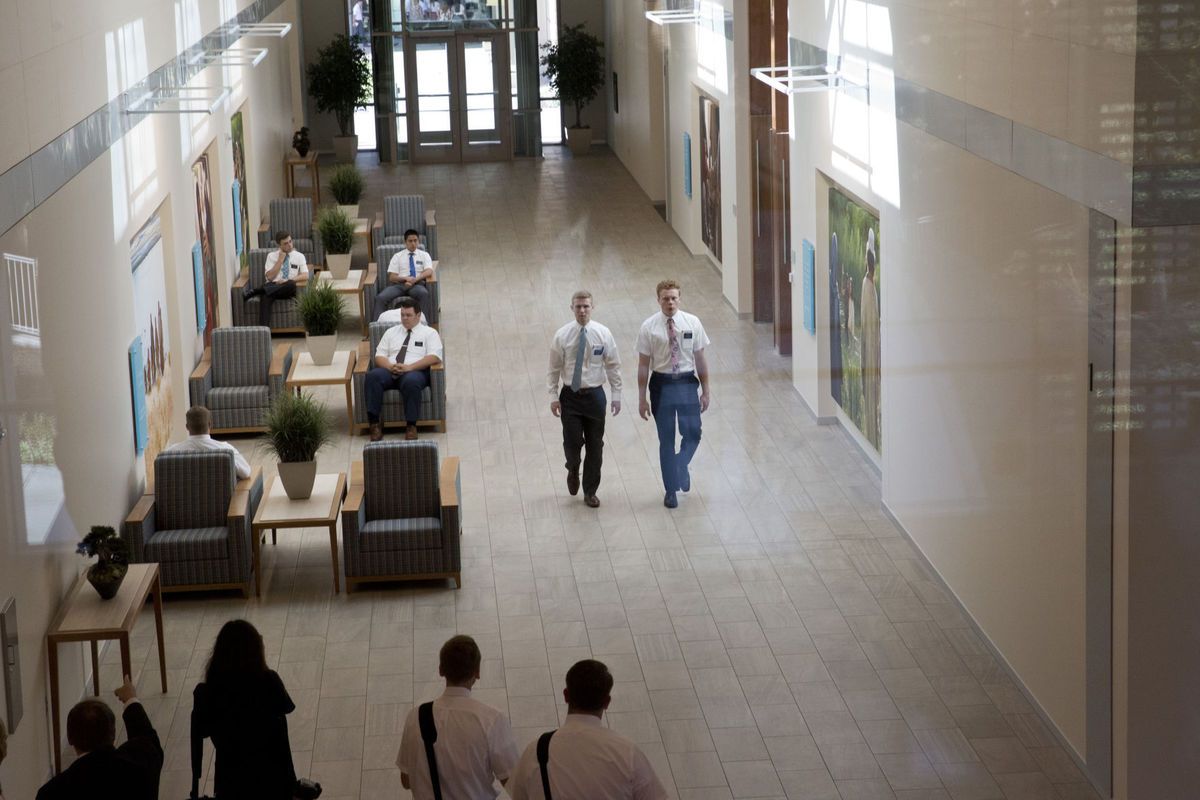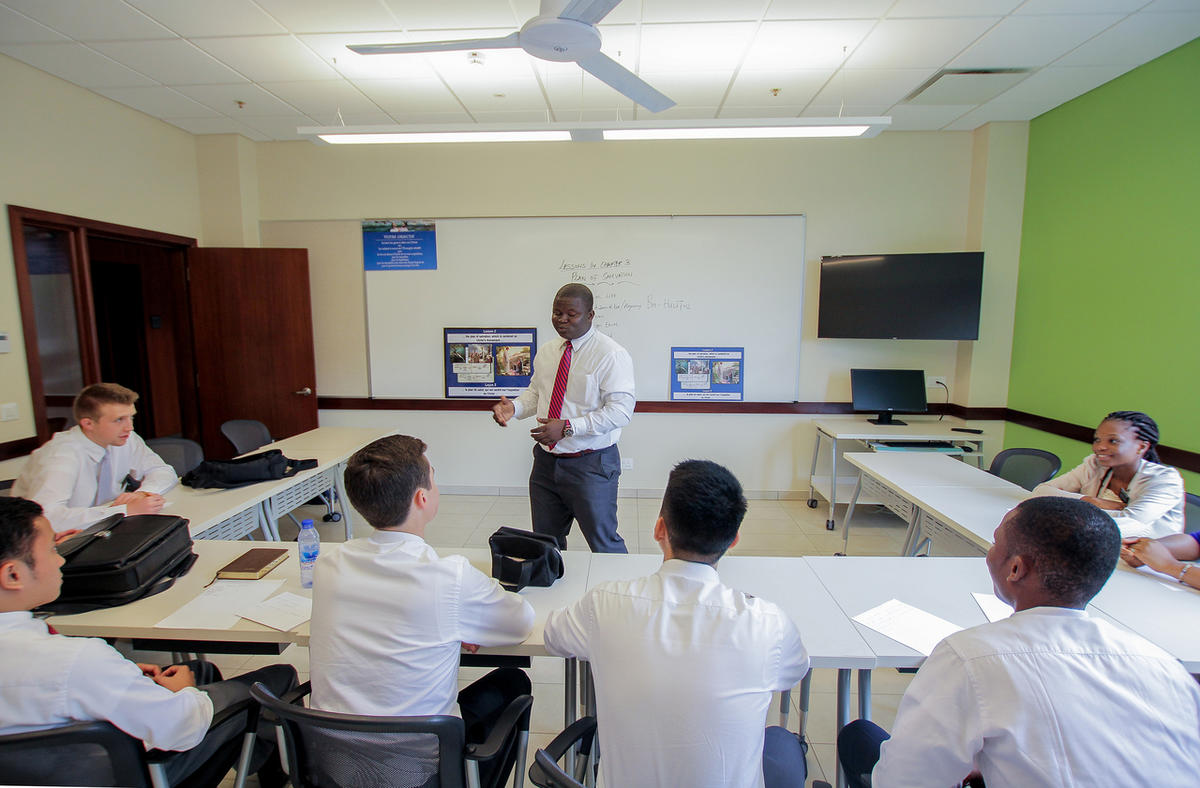Difference between revisions of "Missionary Training Center"
(→External Links) |
m |
||
| Line 1: | Line 1: | ||
| − | [[Image: | + | [[Image:New_Provo_MTC_Building.jpg|300px|thumb|<center><span style="color:#0000FF">Provo Utah Missionary Training Center</span></center>|right]] |
| + | Each week, hundreds of families around the world bid farewell to their sons and daughters, sisters and brothers, as they embark on an 18-month (females) to 24-month (males) journey as [[Mormon Missionaries|Mormon missionaries]], fulfilling the Great Commission of taking the Gospel to all the world. Because the daily life of a [[Missionary|missionary]] is demanding – a life that is devoted entirely to teaching others about [[Jesus Christ]] and serving the needy – the first stop on the journey for each new missionary is at one of [[The Church of Jesus Christ of Latter-day Saints]]’ 15 Missionary Training Centers (often called MTCs). They will spend anywhere from two weeks (for those not learning a foreign language) to nine weeks in training before departing to serve in one of the Church’s 400-plus [[Mission|missions]]. | ||
| − | + | Mormon missionaries generally arrive at an MTC with a basic, foundational knowledge of religion and the scriptures gained from the years of instruction that they receive both at home and at Church. Many Mormon families have daily prayer and scripture study together. Mormon youth also attend weekly [[https://www.lds.org/si/seminary high school]] and [[https://www.lds.org/si/institute college]] religion courses offered by the Church. And, the family generally attends Church together on Sundays for three hours of additional religious instruction. | |
| + | ==The Origin of the Missionary Training Center== | ||
| + | |||
| + | [[The Church of Jesus Christ of Latter-day Saints]] originally started the Missionary Training Center to provide language training, and to provide a place for missionaries to be housed until difficulties in obtaining passports and visas to their assigned areas could be resolved. | ||
| + | |||
| + | The MTC was originally called the "Language Training Mission." The name was later changed in the 1970s to the "Missionary Training Center." The name was changed to note that it was for more than just language training, although language training would continue to be an important part of the facility's function. | ||
| + | |||
| + | ==Preparing Missionaries to Teach the Gospel== | ||
| + | |||
| + | [[Image:Missionary_Training_Center_Ghana.jpg|300px|thumb|<center><span style="color:#0000FF">Missionary Training Center Ghana</span></center>|none]] | ||
| + | |||
| + | From the moment they arrive, the new missionaries are never alone; they are assigned a "companion" who is going to the same mission and will be with them always while at the MTC. The missionaries are not allowed to phone home, chat with friends on the Internet, watch TV or non-Mormon videos, read a novel or a newspaper, listen to popular music, or go on dates. | ||
| + | |||
| + | The rigorous course of study at the MTC is rooted in gospel fundamentals. While at the MTC, missionaries engage in daily practice teaching situations and intense gospel classroom instruction from teachers who are themselves returned missionaries. They also attend weekly devotional addresses from Church leaders and MTC staff and perform weekly service opportunities. Missionaries are encouraged to actively study the Church's doctrine to receive inspiration on how best to teach and help others. | ||
| + | |||
| + | The [https://www.mtc.byu.edu/ Provo MTC], the largest Missionary Training Center campus of the Church, teaches more than 50 languages. It ranks second among the nation’s largest on-site language schools, behind only the U.S. Defense Department’s Language Institute in Monterey, California. Each language instructor is either a native speaker or is fluent thanks to his or her own missionary service. In addition to language instruction, teachers provide cultural training – the use of proper manners and non-confrontational behaviors - to help missionaries make a smoother transition into their assigned foreign country. | ||
| + | |||
| + | For many of these 18 and 19-year-old men and women, this is their first experience of living away from home, so they also learn some of the basic, necessary skills needed to live on their own. | ||
| + | |||
| + | Regardless of the MTC attended, all missionaries are given the chance to further learn the doctrines of Jesus Christ and to develop and strengthen Christlike attributes. Missionaries learn to teach principles with clarity and to help others have faith in Christ, repent, be baptized in Christ's name, receive the Holy Spirit, and continue in the ways of the Savior. | ||
| + | |||
| + | ==Missionary Training Centers Worldwide== | ||
There are currently seventeen MTCs, in the following locations: | There are currently seventeen MTCs, in the following locations: | ||
| Line 22: | Line 44: | ||
* Accra, Ghana | * Accra, Ghana | ||
* Johannesburg, South Africa | * Johannesburg, South Africa | ||
| − | |||
| − | |||
| − | |||
| − | |||
| − | |||
| − | |||
===Updates=== | ===Updates=== | ||
Revision as of 09:12, 9 August 2017
Each week, hundreds of families around the world bid farewell to their sons and daughters, sisters and brothers, as they embark on an 18-month (females) to 24-month (males) journey as Mormon missionaries, fulfilling the Great Commission of taking the Gospel to all the world. Because the daily life of a missionary is demanding – a life that is devoted entirely to teaching others about Jesus Christ and serving the needy – the first stop on the journey for each new missionary is at one of The Church of Jesus Christ of Latter-day Saints’ 15 Missionary Training Centers (often called MTCs). They will spend anywhere from two weeks (for those not learning a foreign language) to nine weeks in training before departing to serve in one of the Church’s 400-plus missions.
Mormon missionaries generally arrive at an MTC with a basic, foundational knowledge of religion and the scriptures gained from the years of instruction that they receive both at home and at Church. Many Mormon families have daily prayer and scripture study together. Mormon youth also attend weekly [high school] and [college] religion courses offered by the Church. And, the family generally attends Church together on Sundays for three hours of additional religious instruction.
Contents
The Origin of the Missionary Training Center
The Church of Jesus Christ of Latter-day Saints originally started the Missionary Training Center to provide language training, and to provide a place for missionaries to be housed until difficulties in obtaining passports and visas to their assigned areas could be resolved.
The MTC was originally called the "Language Training Mission." The name was later changed in the 1970s to the "Missionary Training Center." The name was changed to note that it was for more than just language training, although language training would continue to be an important part of the facility's function.
Preparing Missionaries to Teach the Gospel
From the moment they arrive, the new missionaries are never alone; they are assigned a "companion" who is going to the same mission and will be with them always while at the MTC. The missionaries are not allowed to phone home, chat with friends on the Internet, watch TV or non-Mormon videos, read a novel or a newspaper, listen to popular music, or go on dates.
The rigorous course of study at the MTC is rooted in gospel fundamentals. While at the MTC, missionaries engage in daily practice teaching situations and intense gospel classroom instruction from teachers who are themselves returned missionaries. They also attend weekly devotional addresses from Church leaders and MTC staff and perform weekly service opportunities. Missionaries are encouraged to actively study the Church's doctrine to receive inspiration on how best to teach and help others.
The Provo MTC, the largest Missionary Training Center campus of the Church, teaches more than 50 languages. It ranks second among the nation’s largest on-site language schools, behind only the U.S. Defense Department’s Language Institute in Monterey, California. Each language instructor is either a native speaker or is fluent thanks to his or her own missionary service. In addition to language instruction, teachers provide cultural training – the use of proper manners and non-confrontational behaviors - to help missionaries make a smoother transition into their assigned foreign country.
For many of these 18 and 19-year-old men and women, this is their first experience of living away from home, so they also learn some of the basic, necessary skills needed to live on their own.
Regardless of the MTC attended, all missionaries are given the chance to further learn the doctrines of Jesus Christ and to develop and strengthen Christlike attributes. Missionaries learn to teach principles with clarity and to help others have faith in Christ, repent, be baptized in Christ's name, receive the Holy Spirit, and continue in the ways of the Savior.
Missionary Training Centers Worldwide
There are currently seventeen MTCs, in the following locations:
- Provo, Utah (USA)
- Preston, England
- Buenos Aires, Argentina
- Sao Paulo, Brazil
- Mexico City, Mexico
- Santiago, Chile
- Bogotá, Colombia
- Lima, Peru
- Guatemala City, Guatemala
- Hamilton, New Zealand
- Manila, Philippines
- Tokyo, Japan
- Seoul, South Korea
- Santo Domingo, Dominican Republic
- Madrid, Spain
- Accra, Ghana
- Johannesburg, South Africa
Updates
On August 25, 2011, The Church of Jesus Christ of Latter-day Saints announced that it will build a new state-of-the-art building at the MTC in Provo, Utah, the largest Missionary Training Center campus of the Church. The new building will replace the Melvin J. Ballard building which will be demolished as part of the construction process.
While the existing Melvin J. Ballard building has two floors above grade, the new building is being designed to have several more floors above grade. The new building will house classrooms equipped with modern technological resources to be used by missionaries. Demolition of the existing building is anticipated to begin early in 2012, with construction of the new building scheduled to be complete by fall of 2013.
External Links
- LDS Church seeks to expand the MTC in Provo.
- The Provo MTC website
- About Mormonism - contains many facts about missionaries and their training.
- A Look at the Mormon Missionary Training Process
- Missionary Training Centers around the World
- Mormons are Rising in Business and Politics. Does that begin at the MTC? -- from the Christian Post
- New buildings at the Provo, Utah, MTC

